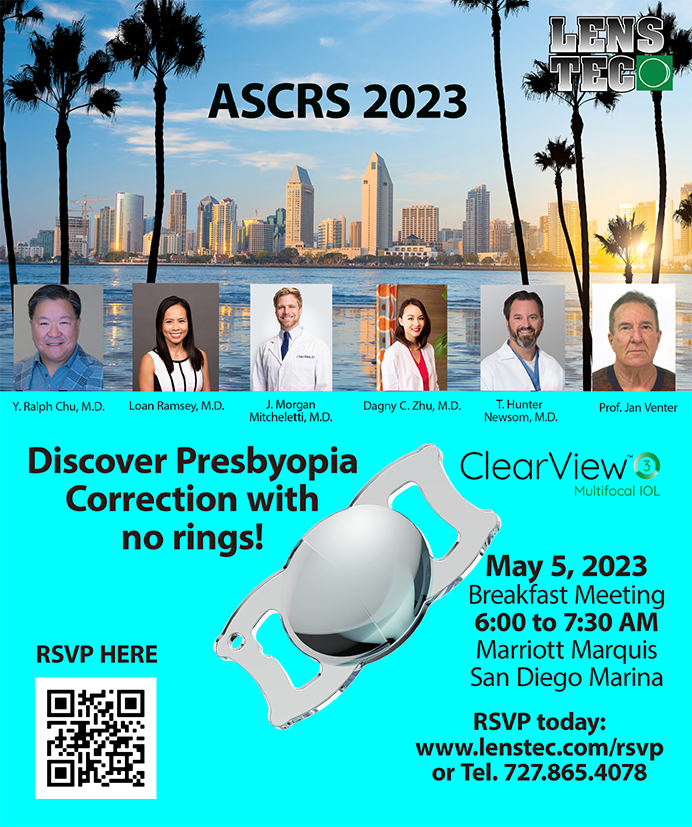I combine a “moderate motion” phaco technique and the use of Healon5 (Advanced Medical Optics, Inc., Santa Ana, CA). My approach is an extension of the wonderful low-flow concept that Robert Osher, MD, of Cincinnati introduced many years ago. I use higher settings than Dr. Osher originally proposed, however, and thus may move more efficiently and rapidly through the procedure and use less phaco power than I might need with lower settings.
TECHNIQUE
I begin a case by injecting a topical intracameral anesthetic, making the incision, and then injecting Healon5. With floppy irides, this ophthalmic viscosurgical device (OVD) does an excellent job of dilating the IFIS pupil, because there is little resistance to its mechanical force. Equally valuable is the way in which Healon5 tamponades the iris; once the OVD is in place, the iris acts much more normally.
Next, I proceed with phacoemulsification. It is essential to use settings that are low enough to retain the viscoelastic in the eye during surgery. I have found that, if I keep my flow rate at approximately 20mL/min and my vacuum level below 300mmHg, I am almost always able to preserve the viscoelastic.
Managing IFIS cases with Healon5 requires modifying one's phaco technique. For a surgeon who relies upon vacuum to pull forward and extract nuclear material, the operation can be more tedious. I happen to be comfortable using a modified stop-and-chop technique. After splitting the nucleus, I mechanically break off pieces of it using little or no vacuum. I do so by placing the horizontal chopper peripheral to the equator of the lens, positioning the phaco tip against the wall of the heminucleus to provide counter pressure, and then simply chopping off fragments mechanically. I find it useful to leave the chopper in the split to hold adjacent nuclear material away as I use vacuum and phacoemulsification to extract the first nuclear fragment.
Almost always, this procedure keeps enough viscoelastic in the eye that I do not need to reinject any during the emulsification process. If the pupil starts to constrict, I simply reinject Healon5, and the pupil redilates beautifully. When the OVD is aspirated during I/A, the pupil may indeed constrict. Because I use a bimanual technique in these cases, however, I do not need to use iris hooks. I can comfortably work through a pupil as small as 3mm to remove the cortical material.
At this point, I inject more Healon5 to dilate the pupil and inflate the capsular bag. I then insert the IOL and place the coaxial or bimanual aspiration tip beneath it in order to remove the Healon5 entirely.
It is during those moments of I/A and occasionally during the final removal of the Healon5 that the billowing characteristic of a floppy iris occurs. Keeping the bottle height at a reasonable level and moving expeditiously will avoid problems.
Considerations for everyday cataract cases
OVD
I recommend that those new to using a viscoadaptive OVD begin by employing it in routine cases in order to become acquainted with its intraoperative characteristics. Healon5 requires certain important steps to avoid complications. Some key tips for OVD management during the creation of the capsulorhexis, hydrodissection, and nuclear removal follow.
Capsulorhexis
Because of the resistance created by the remarkable viscosity of Healon5, I forego my usual technique of creating the capsulorhexis with a bent needle. Specifically, I find it harder to fold the capsule over and control it using a bent needle in the presence of Healon5. For that reason, I typically start the capsulorhexis with a bent needle and then complete it with a forceps.
Hydrodissection
One must ensure that, during the hydrodissection, there is a path through which the fluid may escape the eye. Healon5 can block fluid egress, theoretically increasing the risk of blowing out the posterior capsule. As I enter the anterior chamber with my cannula, I move it around a bit to create a path for the fluid to escape. I inject the BSS a little slowly and in small quantities and make sure that I do not see any unusual distension of the anterior chamber itself.
OVD's Removal
I can easily visualize the Healon5 and thus ensure its complete removal. Moreover, the OVD has great followability at high flow and vacuum rates. Occasionally, a fragment of the OVD is chopped off or becomes isolated. More typically, however, one can extract all of the Healon5 at once upon initiating its removal.
The critical point is to remove all of the Healon5 from beneath the IOL. Actually, regardless of what OVD I use, I always place my aspiration tip beneath the IOL at the end of the case to ensure that I do not leave any viscoelastic in the capsular bag.
CLOSING THOUGHTS
I have found that Healon5 has added flexibility to my complicated IFIS and other types of cataract cases (eg, eyes with Fuch's dystrophy, in which I combine Healon5 with a dispersive agent). It is easy to learn these techniques through practice in everyday cases. I teach them to my residents for the proper use of Healon5 and feel that this OVD is a great addition to our armamentarium.
Douglas D. Koch, MD, is Professor and the Allen, Mosbacher, and Law Chair in Ophthalmology at the Cullen Eye Institute, Baylor College of Medicine, Houston. He is a paid consultant for Advanced Medical Optics, Inc., and for Alcon Laboratories, Inc. Dr. Koch may be reached at (713) 798-6443; dkoch@bcm.tmc.edu.


